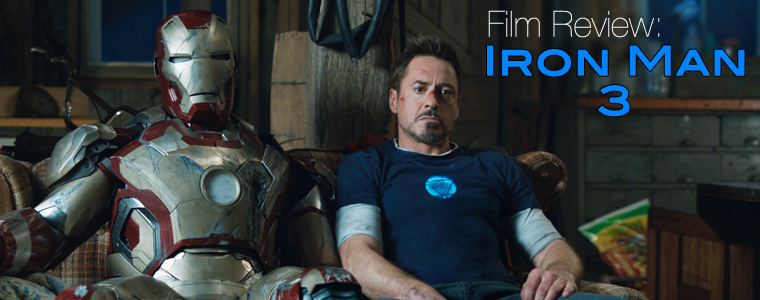Clever Moments, Worn-out Tropes
by Andrew Collins
At film number three, the Iron Man series is starting to feel like the Pirates of the Caribbean franchise. The first film had a solid story and was wildly entertaining thanks to a brilliant central character — Johnny Depp’s Captain Jack Sparrow. The following films? Not so much, but they at least make it worth our time by offering two hours of simply watching Captain Jack be Captain Jack.
In Iron Man 3, the same goes for Robert Downey Jr.’s Tony Stark. As in the first two Iron Man films, Stark dominates throughout on sheer force of personality — casting threats at villainous guards while zip-tied to a bed frame, vainly trying to match wits with a 10-year-old (a younger, poorer version of himself), and brushing off the rest of the world with deadpan quips. Though peppered with clever strokes and a few thoughtful moments, the film as a whole stumbles over worn-out tropes, strained verisimilitude, and gaping holes in the internal laws of the Iron Man universe.
Perhaps the oddest choice in the making of this film was the decision to set it during the Christmas season. Some have gamely tried to impose an interpretation of Charles Dickens’ A Christmas Carol onto the film, as Stark must allegedly confront the ghosts of his past, present, and future in various forms, but it’s a stretch. A large part of the responsibility for this, I suspect, falls in the lap of Shane Black, the man behind “Kiss Kiss Bang Bang” and the “Lethal Weapon” films. Black replaced Jon Favreau as Iron Man director for the third film, and apparently decided to make the holiday theme his central creative stamp. For viewers approaching the film cold, the Christmas setting distracts more than it adds, because it has no great significance in a film released in May.
Details like Christmas aside, we understand that superhero films must stretch believability. Iron Man 3, however, pushes the envelope a little too far, in some cases even breaking its own internal laws. Stark limps through most of the film with a malfunctioning prototype suit that tracks him via an implanted computer chip and flies to him in pieces — a glove, a boot, helmet, visor, etc. At one comedic point, Stark takes on a half-dozen armed guards with just an Iron Man boot and glove. Then, at the film’s climax, he summons an army of self-piloted Iron Man suits, rendering almost all of the earlier drama meaningless. What is the point of building a suit that breaks apart and flies to you in pieces when you could have a complete, fully-functioning one that flies to you all at once?
The plot also falls into classic superhero tropes a bit too obviously — beginning with the villain-turned-evil-by-the-rejection-of-the-hero. Several years earlier when Stark was still in his playboy phase, the nerdy, disabled scientist Aldrich Killian (Guy Pearce) broke through a crowd and approached Stark with an offer to team up. Stark said he would meet him on the roof in ten minutes, but never showed. Years later, to no one’s surprise, Killian is back with a devilishly handsome makeover and improved genetic technology that allows him to regenerate lost limbs, heal injuries and basically turn into lava – developed without Stark’s help. When Stark Industries rejects him a second time, courtesy of Pepper Potts (Gwyneth Paltrow), Killian decides to take over the world with a scheme that includes creating a terrorist mastermind and bribing the Vice President. All this fits well with Stark’s character arc from selfish prick to selfless hero, but this plot sequence has been done to the point of cliche in the past decade.
(As a side note, it doesn’t help that Killian’s superpowers stretch believability to the point of distraction. I’ve always had a hard time embracing the idea of instant physical regeneration, because it’s so obviously impossible. The physical matter to regenerate an entire limb in minutes simply isn’t there. It irked me last summer in “The Amazing Spiderman,” and it annoyed me just as much this time.)
In terms of Tony Stark’s character, Iron Man 3 did come through in one major area where the second film failed: it completed the transformation of Stark from a self-centered “genius, billionaire, playboy, philanthropist,” to a man who sincerely cares for those around him and recognizes that his actions, even if not actively hurtful, have consequences on the lives of others.
After Killian destroys Stark’s house and kidnaps Pepper, the villain goads Stark into action by torturing the young woman with his new genetic recoding process, which happens to inflict incredible pain while one’s body decides to either accept it or explode. When Iron Man arrives, Killian all but defeats him, only to be felled by a final stroke of (incredibly predictable) poetic justice. The genetic transformation that the villain foisted on Pepper as an instrument of torture completes itself, and (surprise!) Killian falls to the same sword he lived by.
Despite the obvious contrivance and predictability of this ending, we can find some catharsis in seeing the arrogant hero, a man who thought he could make himself all-powerful, forced to confront his limitations — and even his mortality — as the one person he most wanted to save ends up saving him instead.
It’s not a bad idea, as character arcs go. I just wish the film had done a better job of earning that emotional payoff, instead of smashing the point into our heads with its artificially regenerated limbs.








